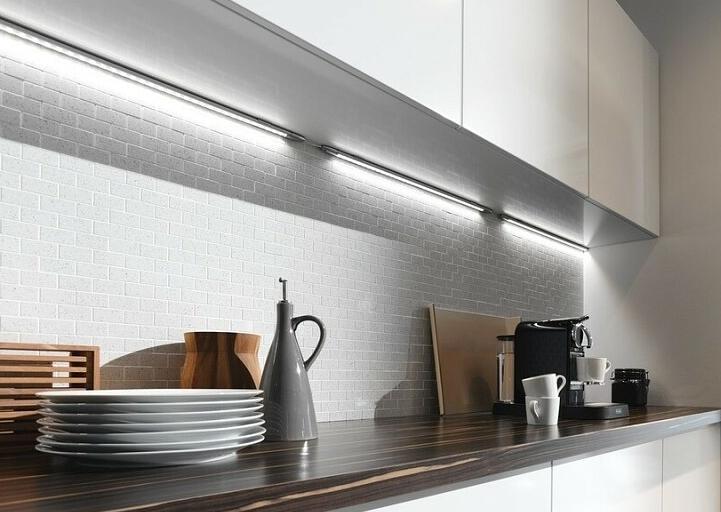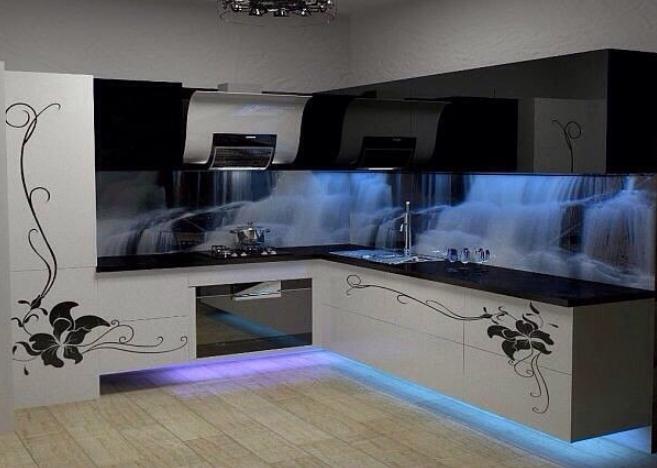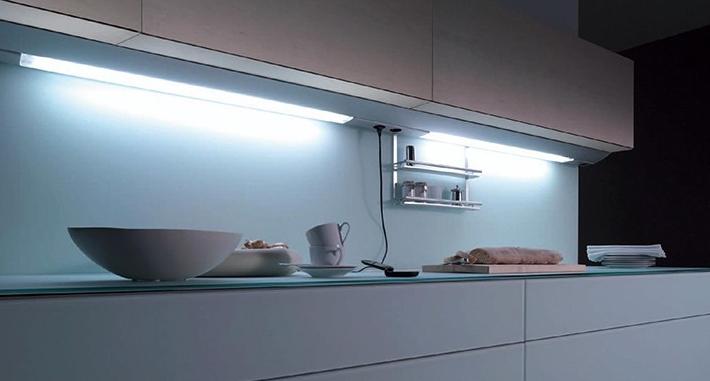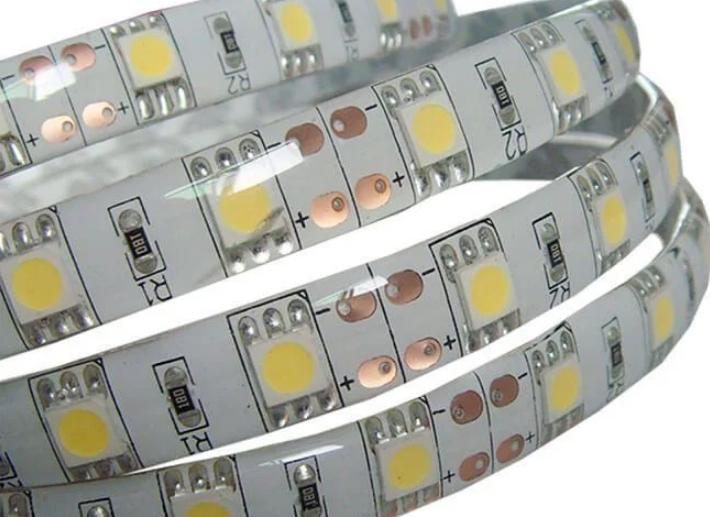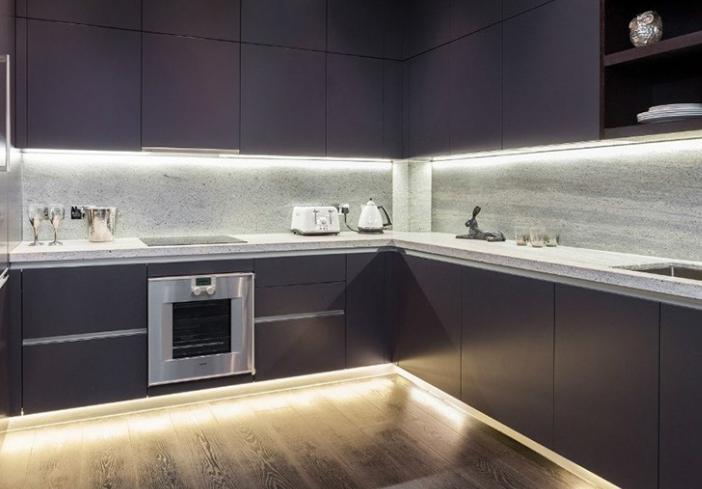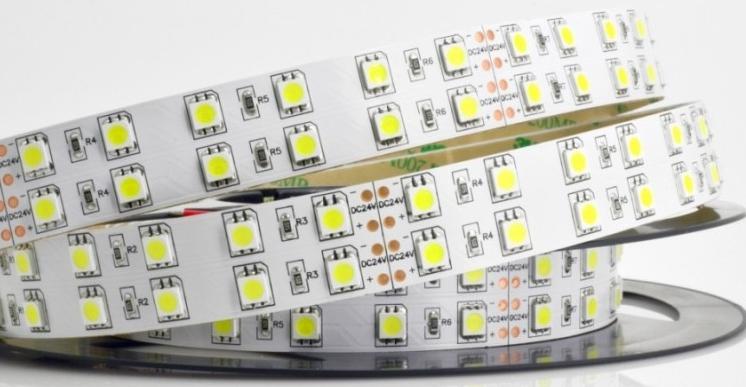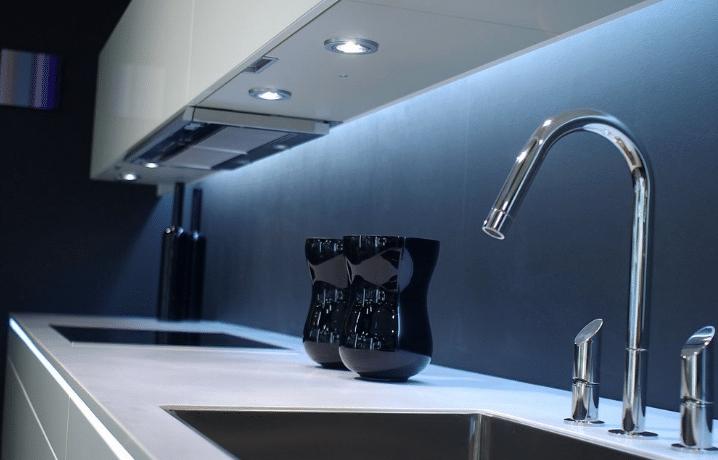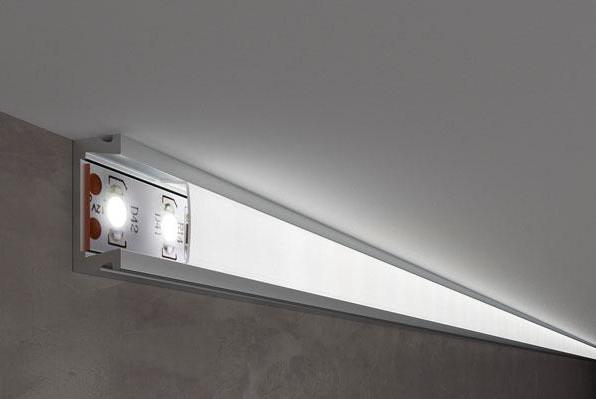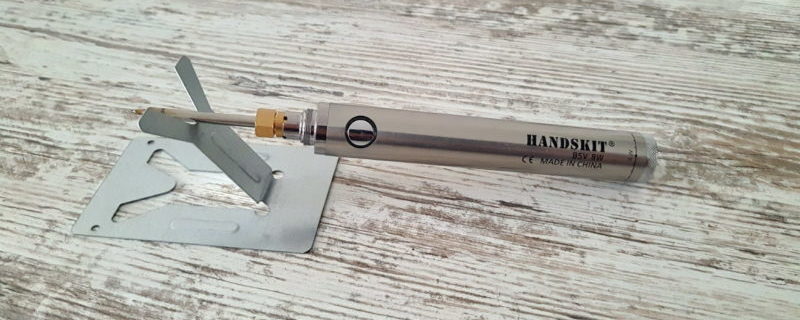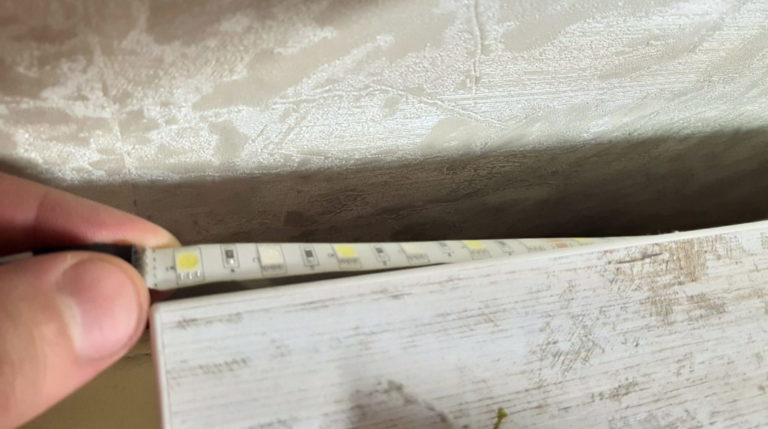Installing under-cabinet lighting in the kitchen
Backlighting for the kitchen under cabinets simplifies cooking, highlights the work area and serves as an element of interior design. With its help, you can highlight a zone in the room or accentuate the beautiful apron that covers the space under the cabinets. There is no need to call in specialists and spend extra money for installation, the work can be done by anyone with basic skills in soldering and wiring.
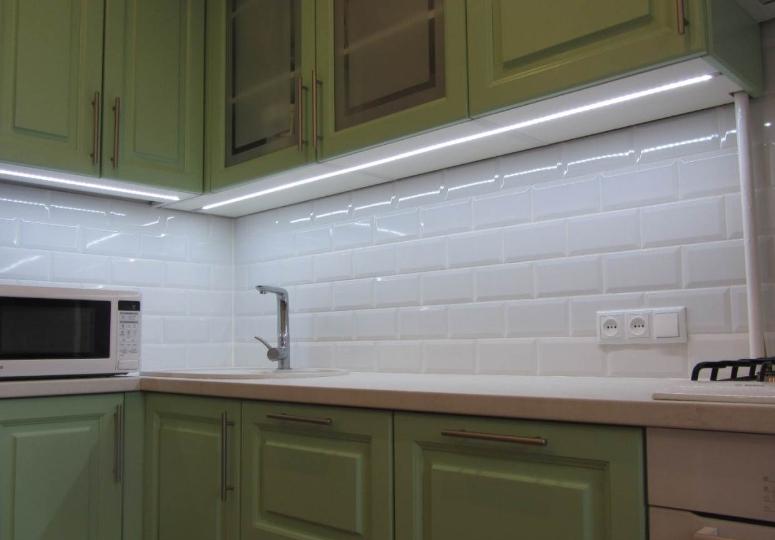
Purpose of backlighting and basic installation options
This type of lighting began to be used relatively recently due to the fact that previously the lamps and lights were too bulky and took up a lot of space, which is unacceptable when mounted under the kitchen cabinets. With the development of technology, there are new, compact lamps that take up little space, while well illuminate the space and can have different color temperatures. This allows you to choose the light intensity that is comfortable for your eyesight.
Originally, backlighting was used for practical purposes and illuminated the work area, which made cooking more comfortable. At the same time, you could save on general lighting, as it used to be made more powerful, so that there was enough light on the work surfaces. But a common chandelier or spotlights on the ceiling do not give quality lighting, because they are far away and from the body and hands of the person constantly falls shadow.
After the advent of small lights and LED strips, it became possible to separate the work area. This has made cooking and other work in the kitchen much more convenient. In terms of purpose, the main purposes of backlighting are as follows:
- Providing quality lighting in the kitchen when cooking. This is important for those who make pastries, decorate dishes and spend a lot of time near the work area.
- Decorating the room and creating a light accent that draws attention and highlights the kitchen set against the background.
- Lighting the apron, if it is decorated beautifully or use glass skinali, which is a central element of the furnishings.
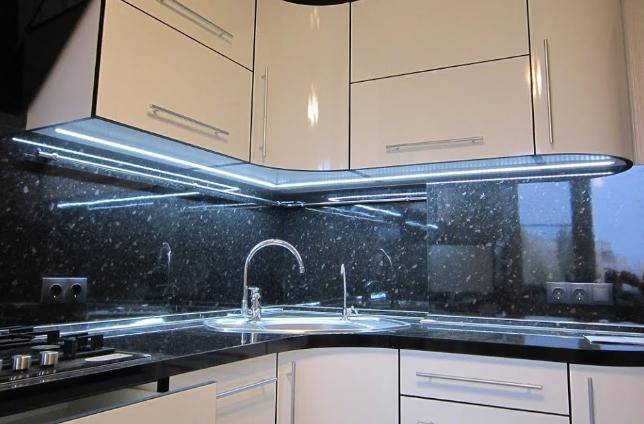
There are several options for installation, each has features depending on how it is mounted and the equipment used:
- Mounting the LED strip along the outer edge of the hinged cabinets. Suitable for most kitchens, allows you to illuminate the entire work area, as it falls roughly in the middle of the countertop. No matter whether your kitchen is straight or corner, you can adapt to any condition.
- Mounts the strip in the middle or back of the cabinets. Used as a utilitarian light or as a decorative element to highlight the work area. Often put two strips on the outside and inside, they can be turned on together or separately.Option with the installation of tape or lights in the corner between cabinets and the wall.
- Installation of recessed lights. The method is not very well suited for kitchen cabinets due to the fact that you need to cut a through hole and the back of the body will stick out inside the furniture. Often in such cases, they make a niche at the bottom of the cabinets, which is closed after connecting the equipment, so that you can put dishes inside.
- Mounting overhead lights is not a bad solution for the kitchen, as they now come in different sizes and have a small thickness. They can be both point modelsAs well as oblong variants on the length of the cabinet. It is worth choosing fixtures with soft diffused light.
- If the "floating kitchen" option is used, when cabinets are fastened to the walls or the legs are moved away from the edge and invisible, the lighting can also be done from below. This will further enhance the effect of floating furniture and give the kitchen an unusual look.The backlighting at the bottom makes floating kitchens look much more spectacular.
- Installation on the top end of the cabinet can also be used, it carries a decorative function.
Some put the equipment, not drilling through the bottom of the cabinets, and making a recess in it, but this option is difficult to implement without a router.
Varieties of light sources
Several basic options can be used. When choosing, it is worth considering the pros and cons of each:
- Halogen lamps Give a bright uniform light, most often put in spotlights, which can be recessed or surface-mounted. The resource of operation is small, and the power consumption of this option is the highest, so it is not best suited for the kitchen. During operation, the surface gets very hot, which causes burns when you touch the lamp.
- Fluorescent lamps can be in the form of long bulbs or with bases for standard sockets. They give a good bright light, consume little electricity, the service life is long, but there is a risk of failure when turned on when the load is high. Due to the fact that there are mercury vapors inside the bulbs, if the lamps are damaged, they evaporate into the room, and it is not safe.
- LED lamps and light fixtures - are the most economical, with a lifespan of up to 50,000 hours. Diodes give a smooth bright light, which does not change the spectrum over time, does not flicker and comes in different color temperatures. It is also possible to adjust the brightness by installing a dimmer. Do not warm up during operation, which is also important.LED lights are compact in size.
- LED strips Are considered the best solution for highlighting the work area in the kitchen. They take up minimal space, are easy to install and mount, and are safe for humans because they operate from 12 V voltage. Another plus is the possibility of installing RGB strips, which change colors, so you can achieve any decorative effect.
If you order LED strips or fixtures from China, you can save money.
Selection criteria for LED equipment
LED lighting in the kitchen under the hinged cabinets is the best, so it is worth choosing this option. But to ensure long-lasting performance and create a comfortable environment, you need to remember a few tips:
- Do not use standard LED strip and fixtures designed for living rooms. In the kitchen, it is worth installing equipment with protection class IP65 or higher, only this option withstands adverse conditions and will not fail due to changes in temperature and humidity. The indicator is always indicated on the lights, it is written on the packaging or in the instructions for connection. As for the LED strip, waterproof versions are not difficult to distinguish On the silicone sheath.Variants in the silicone sheath is not afraid of water, but they are much hotter.
- Take into account the norm of illumination, per square meter of space should have from 150 to 200 lux. If everything is simple with the lamp, as there is a total power on it, then with the strip is a little more complicated. To calculate the right number of diodes, you need to know the power of one and how many elements per linear meter. They can be from 30 to 120, so it is not difficult to choose the brightness.
- It is better to use SMD LEDsDIP versions take up more space and do not give the same uniform light. More often sell the first version, so there is no problem with buying it.
- Purchase a power supply, it is tailored to the specific conditions. It is necessary to know the total power consumption of LEDs used. Give preference to equipment from well-known manufacturers, do not take the cheapest products, as their quality is not very good. The power of the unit should be at least a quarter more than the consumption of lighting fixtures or strips.
- Operating voltage. On sale there are variants for 12 and 24 V. The first type is more common, so it is used more often. There is no particular difference, but the unit at 12 V is easier to find and it costs cheaper.LED equipment operates from a voltage of 12 V, which means it does not pose a risk to health.
By the way! If you need a bright light, you can buy a strip with two rows of LEDs. It can have 120 elements per meter, so they shine much stronger.
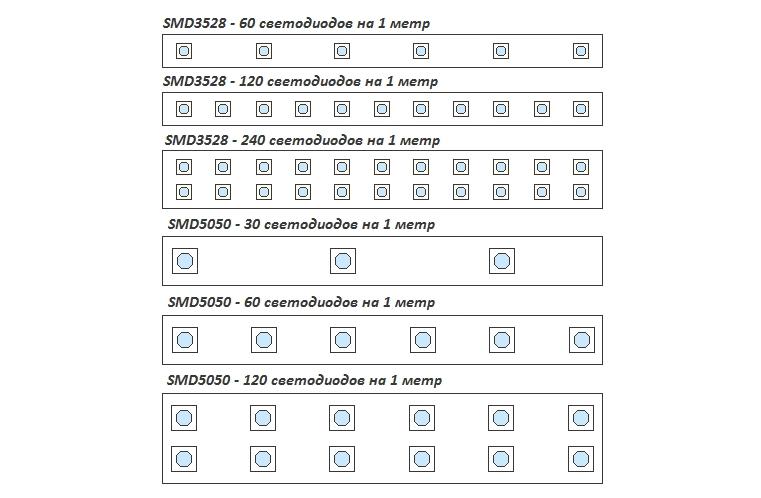
When buying in a store, it is worth inspecting the strip or fixture and assess the quality of workmanship. If the surface is damaged, you can see the flaws and poor quality soldering, it is better to look for another option.
How to choose the color of lighting in the kitchen
Lighting kitchen cabinets with an LED strip or fixture is also good for the fact that you can find any color temperature. When choosing, you can settle on one of these options:
- Natural white light is a comfortable option for cooking and decorating, as it provides good color rendering. It can be both yellowish and light, there are many shades, it is worth choosing at your discretion.
- Warm White Light. Reveals yellowishness or can be quite yellow. Creates a cozy atmosphere and promotes relaxation. Can be used both for decorative purposes, and for cooking, if this option is more to your liking.
- Cold white light. Suitable for modern, high-tech style sets with steel or silver colored fronts. Provides good visibility, sets a cheerful mood, but can distort colors.Cool shades are best for modern interiors.
- Colored lighting is used for decorative purposes, it comes in different shades, so it is easy to choose a suitable one. By adjusting the brightness, you can also adjust the tone.
- Iridescent ribbons allow you to achieve an unusual effect and can change colors at different speeds depending on the settings.
Coloured ribbons RGB can give white light in different shades, but its quality will be lower than that of monochrome options.
Installing LED strip with their own hands
Do the work is not difficult, if you understand the process and prepare everything you need for installation. Tape to pick up in advance, the number to calculate by the size of the cabinets, but always make a small reserve just in case.
Materials and tools
Lighting in the kitchen under the cabinets with LEDs is done in an hour or two, if you prepare everything you need in advance. In addition to the tape you need the following:
- Aluminum profile, the tape is glued to it. This element protects the backlight and serves as a heat sink that removes excess heat. On the profile LED strip works much longer than without it. You can pick up a variant with a diffuser, it is more expensive, but gives a more even light.Profile for LED strip significantly simplifies installation.
- Small self-tapping screws for mounting or strong double-sided adhesive tape on a foam base. You can buy it in an auto store, there the quality of the tape is higher and it withstands adverse effects.
- Screwdriver with a set of drills and nozzles for self-tapping screws, if such fasteners will be used.
- A tape measure and a pencil for measuring and marking.
- Cable to connect the LED strip, select the cross section under the power of the equipment. Usually use 0.74 mm.
- A soldering iron with a small tip as well as solder and rosin.A soldering iron with a fine tip and a usb charger
- Duct tape, heat shrink tubing of appropriate diameter.
- Scissors or a utility knife.
Sometimes double sided tape is unnecessary if the back side of the tape has a good quality adhesive layer. But if it is not trustworthy, it is better to use an additional fixation element.
Installing the tape
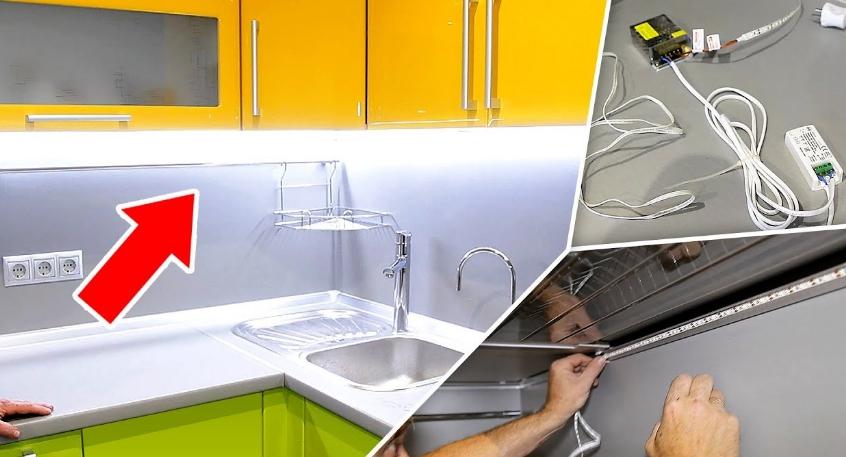
It is important to make all connections airtight to protect them from moisture and damage. Therefore, the work should be done with a number of recommendations in mind:
- Take measurements to accurately determine the length of the pieces of LED strip. Cut it can only be cut in certain places, so the length of the elements should be selected with this point in mind. Cut along the line where there are contacts for connection.
- Determine the location of the power supply and control unit. Often they are placed inside one of the cabinets or put them on top of the wall so that the bottom of the equipment was not visible. After making measurements to cut off pieces of wire for connection, they should be with a reserve, because they need to be connected.
- Bring up the power cable. It is better not to occupy the socket, and take out a separate input, you can be powered from the junction box, and from one of the outlets, such as the one that is connected to the hood.
- Solder the contacts to the ends of the tape. To do this, remove 1.5 cm of insulation, strip the cable ends and firmly connect to the contacts. After the connection cools down, put on 2-3 cm long heat-shrinkable tubing and warm it up so that it shrinks to the necessary size.
- Attach aluminum profile to the bottom ends of the cabinets. If it is too long, cut it with a metal saw. You can use self-tapping screws for mounting, or you can use double-sided adhesive tape. The main thing is to make sure the profile stays firmly in place.
- Drill holes to run wires, if necessary. Or pull them behind the back wall of the cabinets, it all depends on the place of connection. Press the cable carefully to the surface and fix it with special holders.
- Connect all elements of the system. Install the switch, it can be a standard version, as well as a sensor, which turns on when you bring your hand or remote, which lights up when a person approaches. Test the operation.
It is possible to connect the strips to the wire with connectorsYou can connect the strips to the wire with connectors, but in the kitchen, soldering is a more reliable way.
In the conclusion of the video: LED lighting built into the kitchen cabinets handle.
Install lighting under the kitchen cabinets is not difficult, if you use LED strip and follow the simple recommendations. The main thing is to choose the light of the right brightness, so that the work area is well lit.
